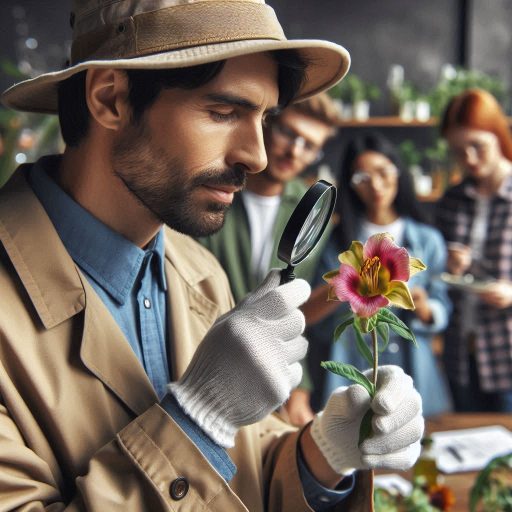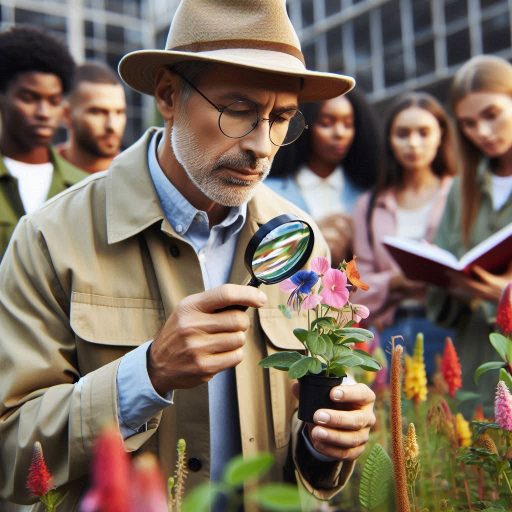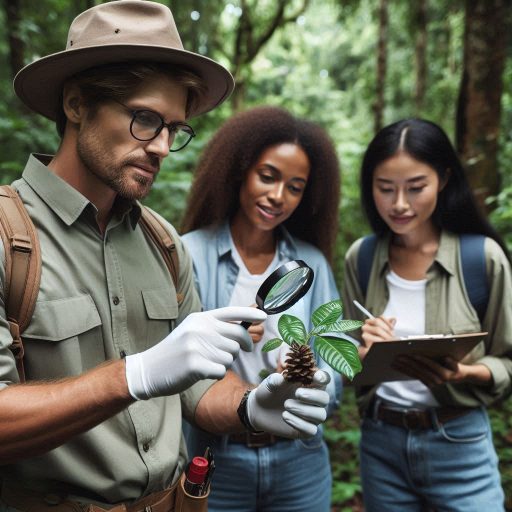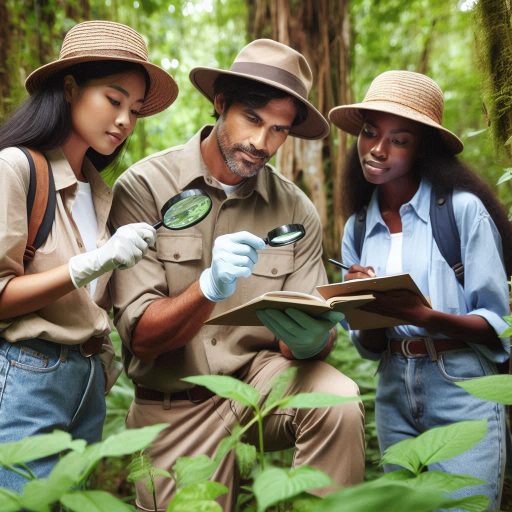Introduction
A day in the life of a professional botanist offers fascinating insights into the complex world of plant life.
Botanists dedicate their careers to studying plants and their ecosystems, uncovering vital ecological relationships that sustain life on Earth.
Their work is essential for understanding biodiversity, plant behavior, and the role of plants in environmental health.
In a typical day, a botanist engages in a variety of tasks, starting with fieldwork.
They often collect plant samples from diverse habitats, such as forests, wetlands, and grasslands.
These excursions allow them to observe plants in their natural environments and gather data on their growth patterns and interactions with other organisms.
Back in the lab, botanists analyze their samples using various techniques.
They examine the physical and chemical properties of plants, studying their structure, genetics, and biochemical processes.
Ultimately, the work of botanists supports sustainable practices and biodiversity preservation.
Through their daily tasks, they contribute significantly to safeguarding our planet’s natural resources.
A day in the life of a botanist is not just about studying plants; it’s about protecting the intricate web of life that sustains us all.
Morning Routine
The typical morning routine of a professional botanist
A professional botanist‘s morning begins with a cup of coffee.
The aroma fills the air, signaling the start of a productive day.
Botanists often wake up early to maximize their time.
They use this quiet time to gather their thoughts and prepare for the day ahead.
Once they finish their coffee, they sit down at their desks.
The first task is checking emails.
They respond to colleagues, students, and researchers.
Effective communication is vital in the botanical community.
Timely responses help keep projects on track and foster collaboration.
Activities Such as Checking Emails
Checking Emails
Upon arrival at the office, the botanist first checks emails.
This task helps stay updated on relevant research and upcoming events.
- Prioritize urgent messages: Address critical communications first.
- Respond to collaborators: Foster relationships with fellow researchers and institutions.
- Review notifications: Stay informed about relevant conferences or seminars.
Reviewing Research
After managing emails, the botanist reviews ongoing research projects.
This process ensures that all tasks align with current objectives.
- Examine data: Analyze recent findings for trends and patterns.
- Assess progress: Check if the research is on schedule.
- Identify challenges: Recognize any obstacles hindering progress.
This review period is crucial for maintaining focus on goals.
Planning Fieldwork
Next, the botanist plans fieldwork activities for the day or week.
Proper planning optimizes time and resources in the field.
- Choose study sites: Select locations based on research needs and previous data.
- Gather necessary equipment: Ensure all tools and materials are ready.
- Coordinate with team members: Confirm schedules and responsibilities.
Planning fieldwork is essential for effective data collection and research success.
Importance of a Clear Plan
Starting the day with a clear plan and purpose is vital for a botanist.
A well-structured morning routine enhances productivity and ensures that tasks align with research objectives.
- Increases efficiency: Knowing the day‘s goals allows for focused work.
- Reduces stress: A planned day minimizes uncertainty and anxiety.
- Fosters teamwork: Clear communication helps the team work together effectively.
A morning routine that includes checking emails, reviewing research, and planning fieldwork cultivates a positive and productive mindset.
The morning routine of a professional botanist plays a crucial role in daily success.
It includes checking emails, reviewing ongoing research, and planning fieldwork.
These activities help establish clear objectives and maintain focus throughout the day.
By starting each day with purpose, botanists can effectively contribute to their research and the broader field of botany.
This structured approach allows for better collaboration and efficient data collection, ultimately leading to more significant scientific discoveries.
Fieldwork
The various tasks involved in fieldwork for a botanist
Fieldwork forms the backbone of a botanist’s daily activities.
Each day begins with planning excursions to various habitats.
Botanists study diverse environments, including forests, wetlands, and grasslands.
They prepare their field gear, ensuring they have all necessary tools.
Plant identification is a crucial task for botanists.
They rely on field guides and mobile apps for assistance.
Botanists use their keen observation skills to recognize plant species.
They examine leaves, flowers, and fruits for specific characteristics.
This process often requires close attention to detail.
Activities such as plant identification, specimen collection, and data recording
Specimen collection follows plant identification.
Botanists collect samples to study later in the lab.
They carefully gather leaves, stems, and seeds, ensuring minimal damage to the plant.
Each specimen is labeled with essential information, such as location and date.
Proper collection techniques ensure that specimens remain viable for research.
Data recording is another vital aspect of fieldwork.
Botanists document their findings meticulously in notebooks or digital devices.
They record information about each species, including its habitat and ecological conditions.
Accurate data helps botanists analyze plant populations and distributions.
This information contributes to broader scientific knowledge.
The Hands-On Nature of Botany
The hands-on nature of botany work makes field days exciting.
Each outing offers new opportunities for discovery and learning.
Botanists often encounter unexpected plants and wildlife, adding to their experience.
They enjoy the thrill of observing rare species in their natural habitat.
Fieldwork fosters a deep connection between botanists and nature.
Being in the field also requires physical stamina.
Botanists often walk long distances over challenging terrain.
They navigate through dense vegetation and rocky landscapes.
This physical aspect of their job promotes health and well-being.
It keeps them engaged and attuned to their surroundings.
Fieldwork allows botanists to develop critical skills.
They learn to work as a team and communicate effectively.
Collaboration with fellow researchers enhances their knowledge and expertise.
Each outing strengthens their passion for botany and conservation.
Fieldwork is an integral part of a botanist’s life.
Plant identification, specimen collection, and data recording are essential tasks.
The hands-on nature of this work fosters a profound connection to nature.
Each field excursion brings excitement, discovery, and valuable insights.
Being in the field reinforces the importance of preserving our plant diversity.
Ultimately, fieldwork shapes the future of botanical research and conservation efforts.
Read: The Impact of Technology on the Chemist Profession in the US
Laboratory Work
The Role of Laboratory Work in a Botanist’s Daily Routine
Laboratory work is a cornerstone of a botanist’s daily routine, filled with diverse tasks that encompass both analytical techniques and innovative research.
I analyze plant samples under the microscope.
I conduct experiments to understand plant behavior.
The lab acts as a vibrant hub of scientific inquiry where collaboration flourishes.
I frequently engage with colleagues, discuss research findings, and exchange ideas to deepen our understanding of complex botanical concepts.
One of my key responsibilities in the lab is sample analysis.
Each day presents an opportunity to delve into the intricate details of various plant specimens.
I rely on sophisticated equipment and techniques to dissect and analyze these samples at a microscopic level.
This detailed examination provides invaluable insights into the fascinating world of plants, revealing hidden patterns and relationships that often go unnoticed.
The Importance of Data Interpretation
In addition to sample analysis, data interpretation is another crucial aspect of my work in the lab.
After collecting data from experiments and field studies, I meticulously analyze and interpret the results to extract meaningful information.
This process involves employing various statistical tools, utilizing software programs, and reviewing scientific literature to make sense of complex data sets.
Drawing scientifically sound conclusions from this data is essential, as it shapes the foundation of my research and contributes to the broader body of knowledge in botany.
Each analysis serves as a stepping stone, leading to new questions and hypotheses that further our exploration of plant biology.
Collaboration and Innovation
Collaboration is also a significant part of my lab work.
I regularly team up with fellow botanists, researchers from other disciplines, and students to carry out experiments and share knowledge.
This collaborative environment fosters creativity and innovation, allowing us to address complex research questions and push the boundaries of botanical science.
By leveraging each other‘s expertise, perspectives, and skills, we can tackle problems that require a multidisciplinary approach.
The lab serves as a platform for innovation and discovery, where novel research ideas are born, tested, and refined.
By harnessing the power of modern technology such as DNA sequencing, advanced microscopy, and bioinformatics tools we can unravel the mysteries of plant life.
These technologies enhance our capabilities, enabling us to investigate the genetic, physiological, and ecological aspects of plants in unprecedented ways.
Our collective efforts in the lab aim to deepen our understanding of plant diversity, ecology, and adaptation in a world that is constantly changing.
Overall, laboratory work is an essential component of a botanist’s daily routine.
It offers tools and an environment for exploring the fascinating world of plants.
You can unravel their mysteries and contribute valuable insights to botanical science.
We deepen our understanding of plant specimens through sample analysis, meticulous data interpretation, and collaborative research efforts.
This knowledge enhances our scientific understanding.
It also paves the way for future discoveries.
These discoveries can address critical issues like climate change, food security, and biodiversity conservation.
As we advance our studies, we honor the complexity and beauty of the botanical world.
We ensure our research contributes to the sustainability and preservation of our planet‘s flora.
Read: US Chemistry Conferences and Symposiums to Attend in 2024
Data Analysis
Data analysis plays a vital role in a botanist’s work.
It helps botanists understand plant species, ecosystems, and environmental changes.
This section discusses the data analysis process and its importance in botanical research.
The Data Analysis Process
Collecting Data
- Botanists gather data through fieldwork, surveys, and experiments.
- They use various tools, including GPS devices, cameras, and field notebooks.
Data Organization
- After collection, botanists organize data for analysis.
- They use spreadsheets or specialized software to categorize and manage information.
Data Cleaning
- Cleaning ensures accuracy by removing errors or inconsistencies.
- Botanists check for duplicate entries, missing values, or outliers.
Techniques Used in Data Analysis
Several techniques assist botanists in analyzing data effectively.
These include:
Transform Your Career Today
Unlock a personalized career strategy that drives real results. Get tailored advice and a roadmap designed just for you.
Start NowStatistical Analysis
- Botanists apply statistical methods to summarize data.
- Techniques such as regression analysis help establish relationships between variables.
- This analysis identifies trends and patterns in plant growth or distribution.
Mapping
- Mapping techniques visualize data geographically.
- Botanists use Geographic Information Systems (GIS) to create detailed maps.
- Maps illustrate the distribution of species and their habitats.
Modeling
- Modeling predicts future changes in ecosystems and plant populations.
- Botanists use simulation models to test hypotheses and predict outcomes.
- This technique helps understand the impact of climate change on biodiversity.
The Importance of Data Analysis
Data analysis provides crucial insights for botanists.
Here‘s how it helps them draw conclusions and make recommendations:
Informed Decision-Making
- Data analysis supports informed decision-making in conservation efforts.
- Botanists can recommend strategies to protect endangered species or habitats.
Identifying Trends
- Analyzing long-term data reveals trends in plant populations and health.
- Botanists can identify shifts in species distributions due to environmental factors.
Assessing Impact
- Data analysis allows botanists to assess the impact of human activities.
- They can evaluate how agriculture or urbanization affects local flora.
Improving Practices
- Botanists use data to improve agricultural practices and sustainable land use.
- Recommendations based on data help enhance crop yields and preserve ecosystems.
Data analysis is fundamental to a botanist’s work.
It involves collecting, organizing, cleaning, and analyzing data using various techniques.
Statistical analysis, mapping, and modeling provide valuable insights.
Ultimately, data analysis helps botanists draw conclusions and make informed recommendations for plant conservation and management.
By employing these methods, botanists contribute significantly to our understanding of plant life and ecosystem health.
Read: Key Roles and Responsibilities of a Chemist in the US
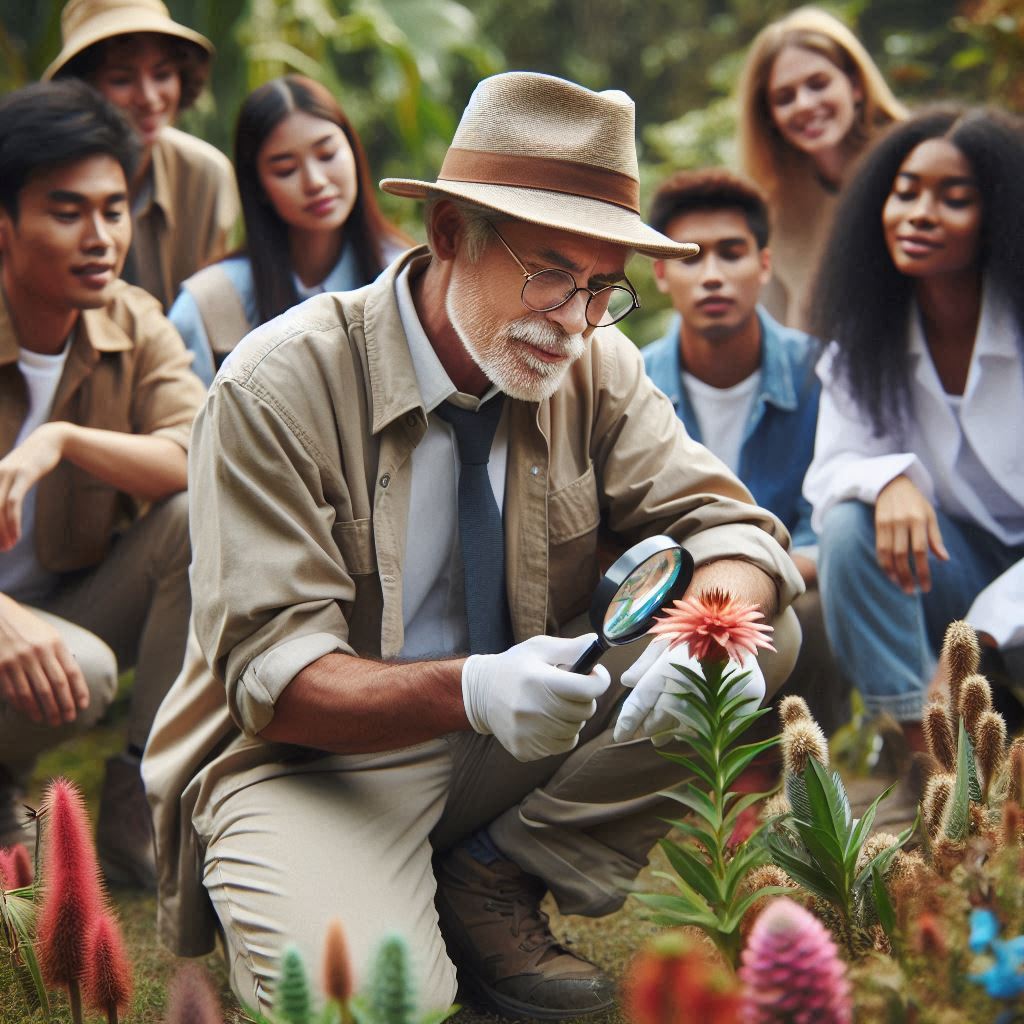
Collaborations
Collaborations are vital for a professional botanist as they offer numerous advantages in the field of botany.
Working with other scientists, researchers, and organizations can significantly enhance the work of a botanist and lead to new discoveries and breakthroughs.
Importance of Collaborations
Collaborations enable professional botanists to access a wider range of resources, both in terms of funding and expertise.
By working together with other professionals in the field, botanists can pool their knowledge and skills to tackle complex research questions and challenges.
Additionally, collaborations provide opportunities for botanists to expand their network and connect with experts from different disciplines.
This cross-disciplinary approach can lead to innovative solutions and fresh perspectives that may not have been possible otherwise.
Working with Other Scientists, Researchers, and Organizations
Professional botanists often collaborate with other scientists, researchers, and organizations to conduct joint research projects, share data, and exchange ideas.
This collaboration can take place at local, national, or even international levels, depending on the scope of the project.
Botanists collaborate with experts to solve biodiversity conservation, climate change adaptation, and sustainable agriculture issues.
These collaborative efforts can help generate impactful research outcomes that benefit society as a whole.
Benefits of Sharing Knowledge, Resources, and Expertise in Botany
Sharing knowledge, resources, and expertise in botany can lead to mutual learning and growth among professionals in the field.
By sharing ideas and best practices, botanists enhance their research methodologies.
They expand their understanding of plant science.
This collaboration helps them develop innovative approaches to solving problems.
Moreover, collaboration allows botanists to access specialized equipment, facilities, and technologies that may not be available to them individually.
This shared access to resources can accelerate research progress and increase the likelihood of achieving significant scientific breakthroughs in botany.
Collaborations play a crucial role in the work of a professional botanist by facilitating knowledge sharing, resource pooling, and expertise exchange.
By collaborating with other scientists, researchers, and organizations, botanists amplify their impact.
They contribute meaningfully to advancing the field of botany.
Read: Earning Potential: Chemist Salaries Across US States
Professional Development
The Ongoing Process of Professional Development for Botanists
Professional development plays a crucial role in the careers of botanists.
Ongoing learning helps botanists enhance their skills and stay relevant in their field.
This section explores essential activities that contribute to professional growth.
Attending Conferences
Conferences offer valuable opportunities for networking and knowledge-sharing.
Botanists can connect with peers and experts in their field.
Attending presentations and workshops helps them learn about recent research and developments.
These gatherings foster collaboration and spark innovative ideas.
Key Benefits of Conferences
- Networking: Meet other professionals and expand your connections.
- Learning: Gain insights from leading researchers and experts.
- Collaboration: Discover potential partnerships for future projects.
Participating in Workshops
Workshops provide hands-on experience in specific techniques and methodologies.
They allow botanists to deepen their understanding of specialized topics.
Through interactive sessions, participants can refine their skills and apply new knowledge.
Benefits of Workshops
- Skill Development: Enhance practical skills relevant to current projects.
- Expert Guidance: Learn directly from experienced professionals.
- Focused Learning: Concentrate on specific areas of interest or expertise.
Engaging in Training Sessions
Training sessions focus on the latest tools and technologies in botany.
These sessions help botanists adapt to changing practices in their field.
Continuous training ensures they remain proficient and efficient in their work.
Advantages of Training Sessions
- Up-to-Date Knowledge: Stay informed about new techniques and tools.
- Professional Growth: Improve competencies and confidence in your work.
- Industry Relevance: Maintain relevance in an evolving field.
Staying Updated on Research and Trends
Botanists must stay current with the latest research and trends.
Reading scientific journals and publications is essential for professional growth.
Engaging with online platforms and forums also helps botanists share insights and experiences.
Ways to Stay Informed
- Follow Journals: Subscribe to reputable botanical and environmental journals.
- Join Online Communities: Engage in discussions with fellow botanists and researchers.
- Utilize Social Media: Follow thought leaders and organizations in botany on social platforms.
Professional development is vital for botanists to thrive in their careers.
By attending conferences, participating in workshops, and engaging in training sessions, botanists can enhance their skills.
Staying updated on research and trends ensures they remain effective in their roles.
Ongoing learning fosters a culture of curiosity and innovation, ultimately benefiting the field of botany as a whole.
Explore Further: How to Publish Your Botanical Research
Outreach and Education
Being a botanist involves more than just fieldwork and laboratory research.
It encompasses a significant commitment to sharing knowledge and fostering a broader interest in the field of botany through outreach and education.
The impact of botanists extends far beyond their research contributions.
They actively engage with communities, schools, and institutions to promote awareness and appreciation of plant life.
Role of Outreach and Education
Botanists play a vital role in educating the public about plant biology, ecosystems, and the intricate relationships that exist within our natural world.
They serve as ambassadors for plants, highlighting their critical importance in sustaining life on Earth.
Plants are not merely background organisms; they are the foundation of our ecosystems, providing oxygen, food, and habitat for countless species.
By communicating this importance, botanists can foster a deeper understanding of environmental stewardship among diverse audiences.
Through various outreach efforts, botanists have the opportunity to engage with different communities, including students, teachers, and the general public.
This engagement can inspire future generations of botanists and environmentalists, nurturing a passion for plant science and conservation.
By connecting with audiences of all ages, botanists can help cultivate a culture that values and respects the natural world.
Activities in Outreach and Education
Botanists participate in a wide range of educational activities aimed at disseminating knowledge and engaging the public.
- Teaching: Many botanists teach in classrooms, botanical gardens, or through community workshops.
They share their expertise with students and enthusiasts, delivering lectures, leading hands-on activities, and guiding field trips.
These educational experiences provide valuable opportunities for students to learn about plant biology and the importance of biodiversity firsthand. - Public Speaking: Botanists often give presentations at conferences, public events, and schools.
They communicate their research findings, share stories from the field, and express their passion for plants.
These presentations inspire listeners to appreciate the significance of plants in our daily lives.
They encourage listeners to engage more in botanical pursuits. - Writing: Many botanists contribute to scientific journals, popular magazines, and blogs, helping to communicate complex botanical concepts in accessible ways.
By writing about their research, plant care, and ecological topics, botanists can reach a broader audience and spark interest in plant science.
This written outreach helps demystify botany and promotes public engagement with the subject. - Community Engagement: Botanists often collaborate with local organizations, schools, and conservation groups to develop educational programs.
These partnerships drive initiatives such as community gardens, plant identification workshops, and conservation projects.
They make botany relevant and engaging for local populations.
Importance of Sharing Knowledge
Sharing knowledge is essential for inspiring others to appreciate the beauty and diversity of plant life.
By disseminating information about plants and their ecological roles, botanists can enhance public understanding of critical environmental issues.
They address challenges like habitat loss, climate change, and biodiversity decline.
They raise awareness about conservation and promote sustainable practices.
Moreover, outreach and education foster a sense of community among plant enthusiasts, amateur botanists, and professionals alike.
This collaborative spirit encourages networking and shared resources, leading to greater innovation and progress in botanical research and conservation efforts.
Overall, outreach and education are integral components of a botanist’s career.
These efforts not only advance scientific knowledge but also cultivate a deeper understanding and appreciation of plants among the general public.
Botanists inspire curiosity and passion for botany.
They contribute to a more informed and engaged society.
This helps society tackle future environmental challenges.
Botanists play a vital role in outreach and education.
They nurture a generation that values plants and biodiversity.
Their efforts foster a commitment to preserving our planet’s rich ecosystems.
Conclusion
A professional botanist‘s day is dynamic and diverse, encompassing a wide range of tasks and responsibilities.
They begin their mornings by reviewing research plans, analyzing previous findings, and preparing for fieldwork.
During the day, they conduct research, collect samples, and analyze data from various environments.
They may spend time in laboratories examining plant specimens or assessing soil conditions.
Collaboration with other scientists and researchers is also crucial, as it fosters the exchange of ideas and knowledge.
Botanists play a critical role in our ecosystem, influencing agriculture, conservation, and medicine.
They contribute to understanding plant behavior, growth patterns, and responses to environmental changes.
Each task that botanists undertake contributes to a greater understanding of and protection for plant life.
Their work supports vital sectors such as food production, natural medicine, and ecological restoration.
By appreciating their contributions, we foster a greater respect for nature and the environment.
Let us celebrate the important work of botanists and their commitment to advancing botanical science.
Their tireless efforts ultimately benefit all of us and ensure a healthier planet for future generations.
Transform Your Career Today
Unlock a personalized career strategy that drives real results. Get tailored advice and a roadmap designed just for you.
Start Now
